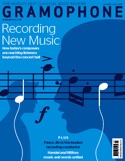Texte paru dans: / Appeared in: |
|
|
Outil de traduction (Très approximatif) |
|
|
Reviewer: David Vickers
Telemann claimed that while a law student he composed a psalm for St Thomas’s every fortnight. His earliest extant sacred work, Ich hebe meine Augen auf zu den Bergen, was probably composed around 1703, and the pattern-based construction of six concise movements reveals Telemann has already cultivated a fondness for contrasting textures using simple means and an uncanny awareness of tuneful vocal writing and delicate rhetorical effects.
Christoph Graupner’s Vergnügte Ruh, beliebte Seelenlust (presumably composed for Darmstadt before 1711) is scored for solo soprano, two recorders, two muted violins and two ‘violettas’. L’Arpa Festante’s softly lyrical playing and Winter’s shapely singing reveal abundant melodious charm and an appealing sense of pastoral instrumental colour in Graupner’s setting of the same Lehms poem that Bach used in 1726 for his sublime alto cantata (No 170).
Proceedings conclude with Heinichen’s modern madrigal-form cantata Herr, nun lässest du deinen Diener, which is a Lutheran treatment of Simeon’s Nunc dimittis for the Feast of the Purification of Mary. Probably composed around 1709, when the former Thomasschule pupil was composer at the opera house and director of the town’s collegium musicum, its centrepiece slow aria is sung consolingly by Hans Jörg Mammel in dialogue with Christoph Hesse’s tender violin obbligato. These excellent performances remind us how many of the finest Saxonian Baroque composers had close ties with the university town long before Bach turned up in 1723.
|
|
|
|
|
|
Cliquez l'un ou l'autre
bouton pour découvrir bien d'autres critiques de CD |
|

/4009350833371.jpg)


